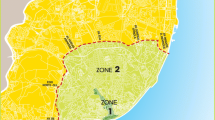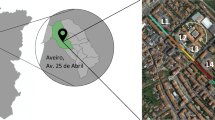Three state of the art traffic–emission–dispersion models dealing with particulate matter have been tested and validated over the Bologna metropolitan area with 2001 data and a future scenario has been developed in order to estimate expected PM concentrations in 2010. The modelling system is composed by a traffic model (VISUM) evaluating vehicle fluxes as a function of mobility demand and road network in the area, an emission model (Trefic) estimating pollutants emitted in atmosphere as a function of vehicle fluxes amount and composition and of environmental conditions and a dispersion model (ADMS) evaluating PM concentrations on the area, given the meteorological variables. The three models compose a cascade sequence and results of the previous one feed the next one. PM concentrations computed by the model suite for the town of Bologna, in northern Italy, for the reference period (January 2001) have been compared with air quality stations measurements suggesting the modelling system being especially suitable for evaluating traffic induced PM. Qualitative and quantitative changes in the circulating vehicle fleet have been supposed in order to obtain a realistic scenario for year 2010. Forecasted concentrations have been then compared with limits fixed by current EU legislation for particulate matter.
Similar content being viewed by others
References
G. Marcazzan, S. Vaccaro, G. Valli and R. Vecchi, Characterisation of PM10 and PM2.5 particulate matter in the ambient air of Milan (Italy), Atmos. Environ. 35 (2001) 4639–4650.
E. Manoli, D. Voutsa and C. Samara, Chemical characterization and source identification/apportionment of fine and coarse air particles in Thessaloniki, Greece, Atmos. Environ. 36 (2002) 949–961.
A. D'Alessandro, F. Lucarelli, P. A. Mandò, G. Marcazzan, S. Nava, P. Prati, G. Valli, R. Vecchi and A. Zucchiatti, Hourly elemental composition and sources identification of fine and corse PM10 particulate matter in four Italian towns, J. Aerosol Sci. 34 (2003) 243–259.
A. Namdeo, G. Mitchell and R. Dixon, TEMMS: an integrated package for modelling and mapping urban traffic emissions and air quality, Environ. Model. Softw. 17 (2002) 177–188.
A. Mediavilla-Sahagún and H. M. ApSimon, Urban scale integrated assessment of options to reduce PM10 in London towards attainment of air quality objectives, Atmos. Environ. 37 (2003) 4651–4665.
PTV, VISUM – Software per la pianificazione e la gestione del trasporto (2003).
Arianet, TREFIC (Traffic Emissions Factors Improved Calculation) – User manual (2003).
Cambridge Environmental Research Consultant, ADMS-Urban user guide (CERC, 2000).
L. Ntziachristos and Z. Samaras, COPERT III computer programme to calculate emissions from road transport – Methodology and Emission Factors (version 2.1). Technical Report No 49, European Environmental Agency (2000).
Cambridge Environmental Research Consultant, Validation and sensitivity study of ADMS-Urban for London, CERC (2003).
R. Berkowicz, OSPM – A parameterised street pollution model, Environ. Monit. Assess. 65 (2000) 323–331.
ANPA, Le reti di monitoraggio della qualità dell'aria in Italia (in Italian), RTI CTN_ACE 3/2000.
WHO, Health impact assessment in the eight major Italian cities, Report EURO/02/5040650 (2002).
M. Berico, A. Luciani and M. Formignani, Atmospheric aerosol in an urban area. Measurements of TSP an PM10 standards and pulmonary depositino assessments, Atmos. Environ. 31 (1997) 3659–3665.
European Commission, The Auto-Oil II Programme, 2000.
I. During, J. Jacob, A. Lohmeyer, M. Lutz and W. Reichenbacher, Estimation of the “non exhaust pipe” PM10 emissions of streets for practical traffic air pollution modelling (2002).
Lenschow et al., Some ideas about the sources of PM10, Atmos. Environ. Suppl. 1 (2001).
Author information
Authors and Affiliations
Corresponding author
Rights and permissions
About this article
Cite this article
Piersanti, A., Monforti, F. & Zanini, G. Simulation of PM10 concentration patterns for a 2010 traffic scenario in Bologna, Italy. Environ Model Assess 10, 291–301 (2005). https://doi.org/10.1007/s10666-005-9016-4
Received:
Accepted:
Published:
Issue Date:
DOI: https://doi.org/10.1007/s10666-005-9016-4




